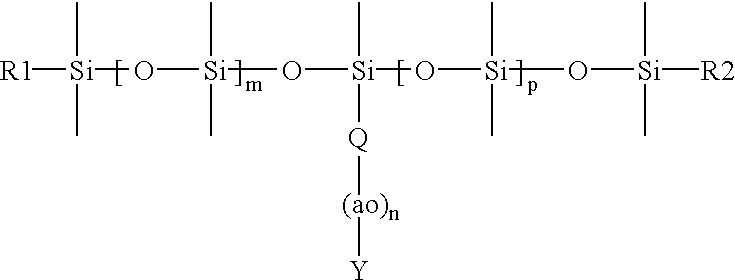Binder resin and synergist composition including a parting agent and process of making lignocellulosic articles
a technology of lignocellulosic articles and binder resin, which is applied in the field of lignocellulosic article making binder resin and synergist composition including a parting agent and the process of making lignocellulosic article, can solve the problems of reducing the physical properties of the formed board, reducing the quantity of lignocellulosic article, and deficient properties of the articles made with such binders. it can redu
- Summary
- Abstract
- Description
- Claims
- Application Information
AI Technical Summary
Benefits of technology
Problems solved by technology
Method used
Image
Examples
example 1
Synthesis of an Internal Parting Agent Where the Hydrophobic Group is Dialkaryl
[0071] Macol.RTM. DNP-10 surfactant (428.4 g) is placed in a one liter two neck flask and heated to 45.degree. C. With continuous agitation, Lupranate.RTM. MI isocyanate (71.6 g) is added dropwise over a period of an hour. The temperature is increased to 80.degree. C. and the reaction is continued for 20 to 24 hours. Titration of remaining free NCO groups shows a % free NCO of about 0.5%. The temperature is maintained for an additional one hour, the reaction mixture is cooled to room temperature and allowed to stand overnight. Titration of free NCO after the overnight period shows the reaction is complete--that is, the measured free NCO is 0.1%, which is within the error of the method.
example 2
Synthesis of an Internal Parting Agent Where the Hydrophobic Group is Silicon
[0072] Masil.RTM. SF-19 surfactant (423 g) is placed in a one liter three neck flask and heated to 80.degree. C. with continuous agitation provided by an overhead stirrer. Lupranate.RTM. MI isocyanate (77 g) is added dropwise over a period of about 30 minutes. The temperature is increased to 90.degree. C. and the reaction is continued for 20-24 hours, after which time the % free NCO is determined by titration and found to be ca. 0.5%. The reaction is continued for an additional 2 hours at 90.degree. C., the reaction mixture cooled to room temperature and allowed to stand overnight. Titration of free NCO shows the reaction is complete.
example 3
Synthesis of an Internal Parting Agent Where the Hydrophobic Group is Alkaryl
[0073] Iconol.RTM. NP-6 (393.5 g) is placed in a one liter two neck flask and heated to 45.degree. C. With continuous agitation, Lupranate.RTM. MI (106.5 g) is added dropwise over a period of an hour. The temperature is increased to 80.degree. C. and the reaction is continued for 20 to 24 hours. Titration of remaining free NCO groups shows a % free NCO of about 0.5%. The temperature is maintained for an additional one hour, the reaction mixture is cooled to room temperature and allowed to stand overnight. Titration of NCO the following morning shows the free NCO is 0.1%, which is within the error of the method, thus the reaction is complete.
PUM
| Property | Measurement | Unit |
|---|---|---|
| Time | aaaaa | aaaaa |
| Percent by mass | aaaaa | aaaaa |
| Percent by mass | aaaaa | aaaaa |
Abstract
Description
Claims
Application Information
 Login to View More
Login to View More - R&D
- Intellectual Property
- Life Sciences
- Materials
- Tech Scout
- Unparalleled Data Quality
- Higher Quality Content
- 60% Fewer Hallucinations
Browse by: Latest US Patents, China's latest patents, Technical Efficacy Thesaurus, Application Domain, Technology Topic, Popular Technical Reports.
© 2025 PatSnap. All rights reserved.Legal|Privacy policy|Modern Slavery Act Transparency Statement|Sitemap|About US| Contact US: help@patsnap.com


